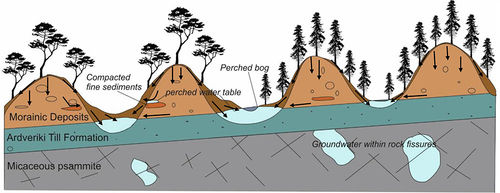OR/17/014 Conclusions
| Archer, N A L, Everest, J. 2017. Final Report: Emergent Forest dynamics and Natural Flood Management. British Geological Survey Internal Report, OR/17/014. |
Following the results and discussion of this investigation, Figure 32, summarises the geological structure of the moraine system, locations of perched water tables and dominant water flow directions inferred by measured soil water contents and Kfs measurements within the Plantation and Old Forest sites. Figure 32, illustrates the necessary presence of the harder till layer to allow for possible perched water tables under the more permeable moraine substrate. Because of the glacial fluvial nature of moraine formation, ponding and compaction caused by retreating ice sheets can create lenses of fine, more impermeable layers to create localised areas of perched water tables within the moraine slopes.
Within the Plantation site, soils and vegetation are significantly shallower than in the Old Forest site and water flow is driven by the highly permeable moraine substrate and drainage lines implemented before tree planting, causing greater infiltration of rainfall downslope to the boggy moraine depressions, where streams flow. Overall the dense plantation canopy tends to intercept and reduce rainfall reaching the ground and during a dry period, the deeper peat soils toward the bottom of the moraine were observed to dry out and crack. However, as there is a lack of high intensity rainfall data in the Plantation site, it is not possible to conclude that the dense canopy also intercepts a high percentage of storm rainfall that may cause flooding. Further rainfall measurements are needed to understand rainfall interception in the Plantation site.
The large range of Kfs values from (0.00004 to 4.80 cm/min) in the Old Forest infers that the soils have the ability to retain (low Kfs values) and release water (high Kfs values) within the moraine slope. These extreme values have developed in the Old forest site, due to the diverse forest understory of sphagnum, blaeberry, heather and bearberry, where the vegetation maintains deeper peat soils and sandy gravel soils dominate the depressions. This causes a ‘dual’ system of water retention in soils below vegetation and water release in the sandy gravel substrate in depressions between vegetation mounds. Such a system allows storage of rainfall in the moraine slope, maintaining a constant supply of water to accumulate above finer more impermeable substrate producing springs within the moraine slope.

In terms of the forest adjusting to its environment to form springs is not clear in this study. The large root system of the ~300 year old Scots pines are difficult to quantify when disturbance must remain at a minimum within the designated SSSI area, but this study has provided a good basis for furthering this work in the future.
The Old Forest site provides a rare opportunity to investigate a system where trees have been left to survive for over three hundred years and perhaps the more diverse system of open tree areas and dense understory may be a natural system to learn form in terms of developing natural flood management options to store and slow down high rainfall events within upland hill slope systems.